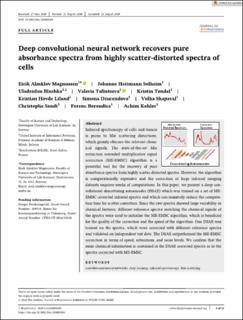| dc.contributor.author | Magnussen, Eirik Almklov | |
| dc.contributor.author | Solheim, Johanne Heitmann | |
| dc.contributor.author | Blazhko, Uladzislau | |
| dc.contributor.author | Tafintseva, Valeria | |
| dc.contributor.author | Tøndel, Kristin | |
| dc.contributor.author | Liland, Kristian Hovde | |
| dc.contributor.author | Dzurendova, Simona | |
| dc.contributor.author | Shapaval, Volha | |
| dc.contributor.author | Sandt, Christophe | |
| dc.contributor.author | Borondics, Ferenc | |
| dc.contributor.author | Kohler, Achim | |
| dc.date.accessioned | 2021-02-25T08:03:54Z | |
| dc.date.available | 2021-02-25T08:03:54Z | |
| dc.date.created | 2020-09-28T20:04:07Z | |
| dc.date.issued | 2020 | |
| dc.identifier.citation | Journal of Biophotonics. 2020, 13 (12), . | en_US |
| dc.identifier.issn | 1864-063X | |
| dc.identifier.uri | https://hdl.handle.net/11250/2730251 | |
| dc.description.abstract | Infrared spectroscopy of cells and tissues is prone to Mie scattering distortions, which grossly obscure the relevant chemical signals. The state‐of‐the‐art Mie extinction extended multiplicative signal correction (ME‐EMSC) algorithm is a powerful tool for the recovery of pure absorbance spectra from highly scatter‐distorted spectra. However, the algorithm is computationally expensive and the correction of large infrared imaging datasets requires weeks of computations. In this paper, we present a deep convolutional descattering autoencoder (DSAE) which was trained on a set of ME‐EMSC corrected infrared spectra and which can massively reduce the computation time for scatter correction. Since the raw spectra showed large variability in chemical features, different reference spectra matching the chemical signals of the spectra were used to initialize the ME‐EMSC algorithm, which is beneficial for the quality of the correction and the speed of the algorithm. One DSAE was trained on the spectra, which were corrected with different reference spectra and validated on independent test data. The DSAE outperformed the ME‐EMSC correction in terms of speed, robustness, and noise levels. We confirm that the same chemical information is contained in the DSAE corrected spectra as in the spectra corrected with ME‐EMSC.image | en_US |
| dc.language.iso | eng | en_US |
| dc.publisher | Wiley | en_US |
| dc.rights | Navngivelse 4.0 Internasjonal | * |
| dc.rights.uri | http://creativecommons.org/licenses/by/4.0/deed.no | * |
| dc.title | Deep convolutional neural network recovers pure absorbance spectra from highly scatter‐distorted spectra of cells | en_US |
| dc.type | Peer reviewed | en_US |
| dc.type | Journal article | en_US |
| dc.description.version | publishedVersion | en_US |
| dc.source.pagenumber | 15 | en_US |
| dc.source.volume | 13 | en_US |
| dc.source.journal | Journal of Biophotonics | en_US |
| dc.source.issue | 12 | en_US |
| dc.identifier.doi | 10.1002/jbio.202000204 | |
| dc.identifier.cristin | 1834542 | |
| dc.relation.project | Norges forskningsråd: 289518 | en_US |
| dc.description.localcode | © 2020 The Authors. Journal of Biophotonics published by WILEY‐VCH GmbH This is an open access article under the terms of the Creative Commons Attribution License, which permits use, distribution and reproduction in any medium, provided the original work is properly cited. | en_US |
| cristin.ispublished | true | |
| cristin.fulltext | original | |
| cristin.qualitycode | 1 | |

